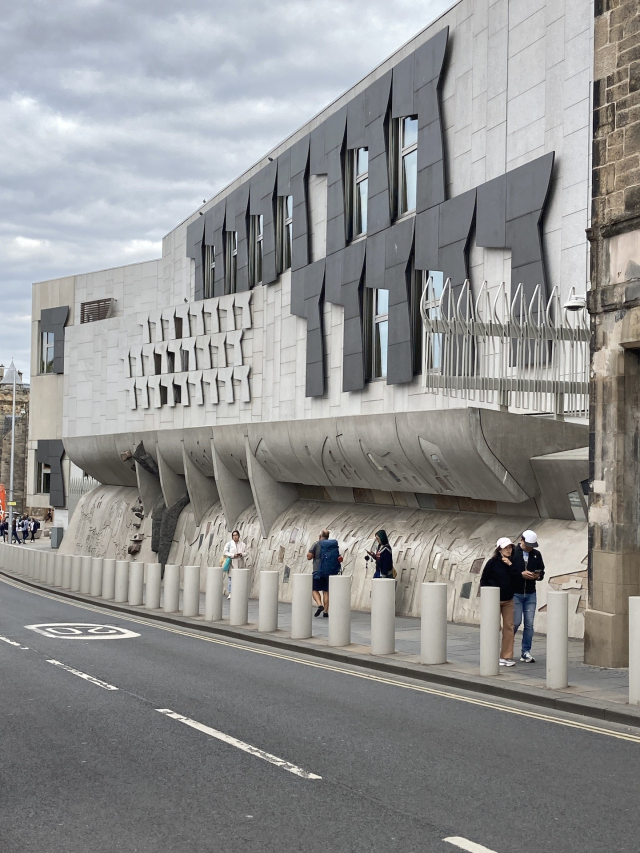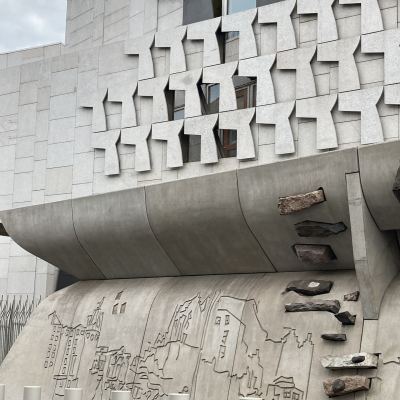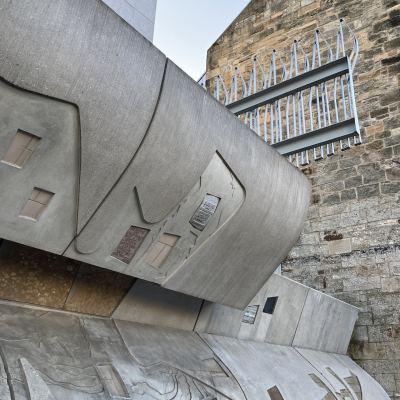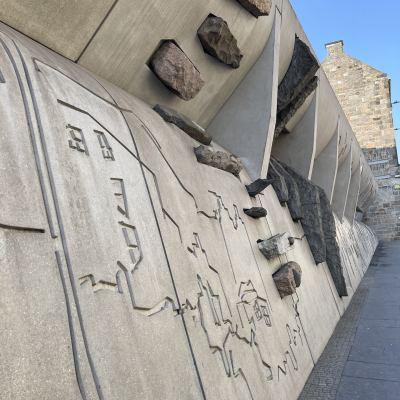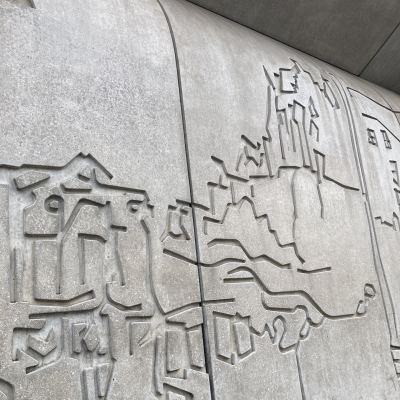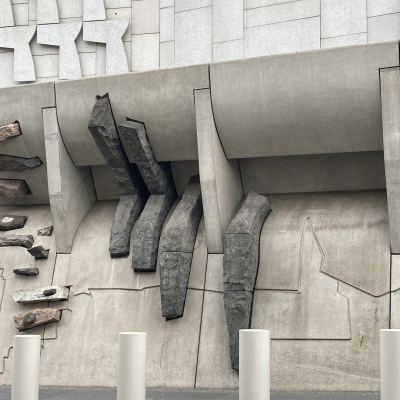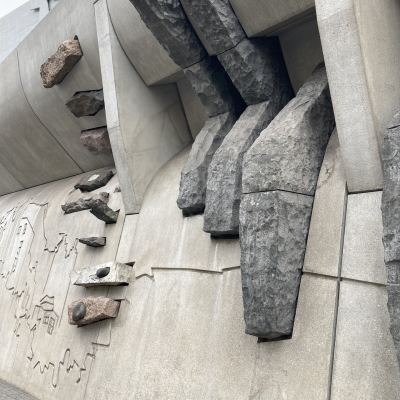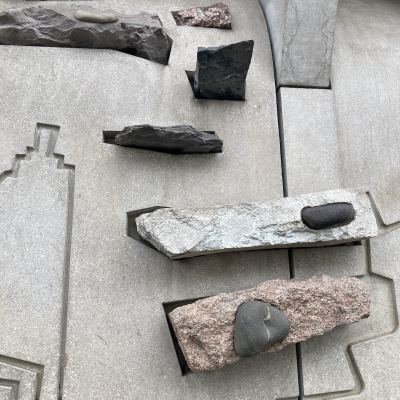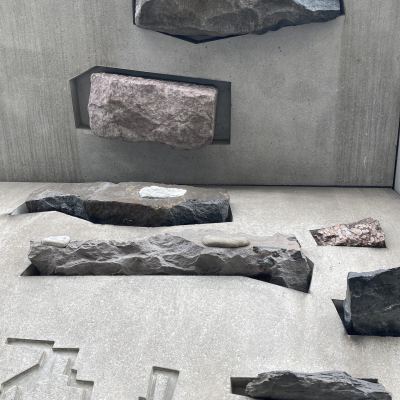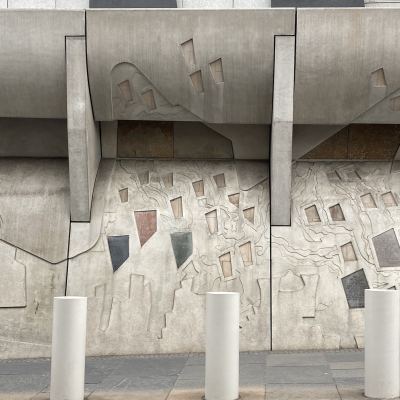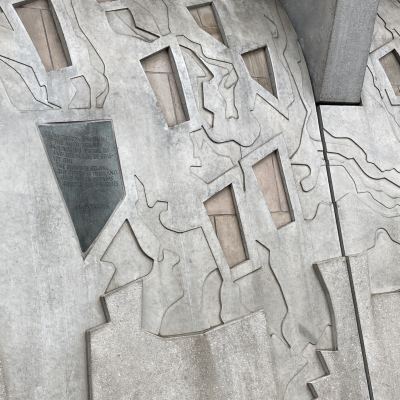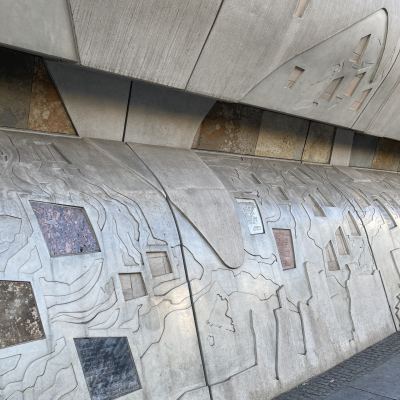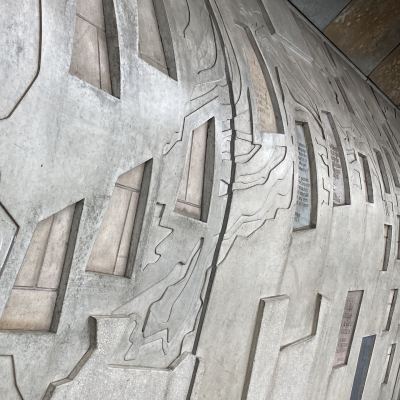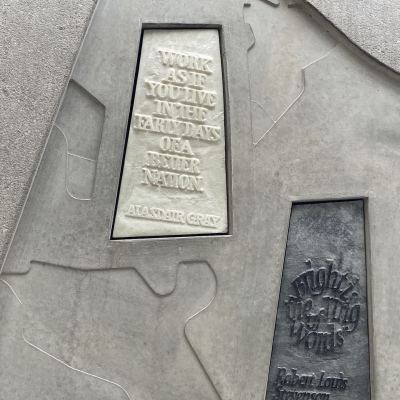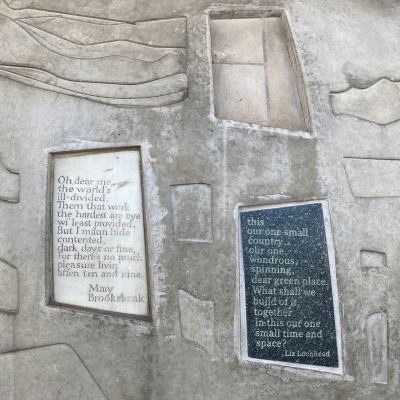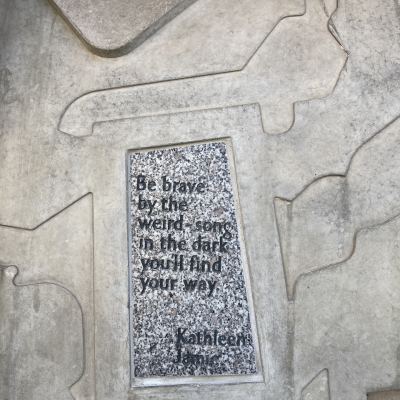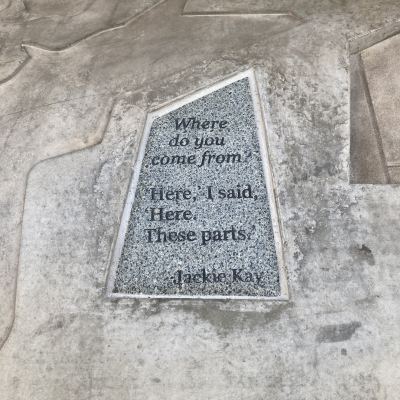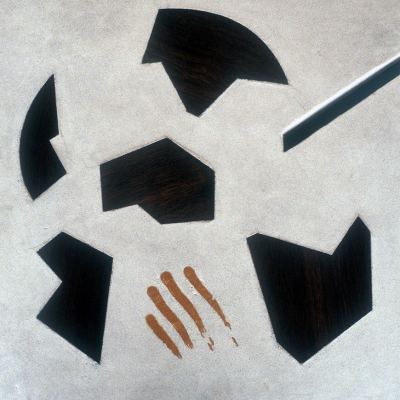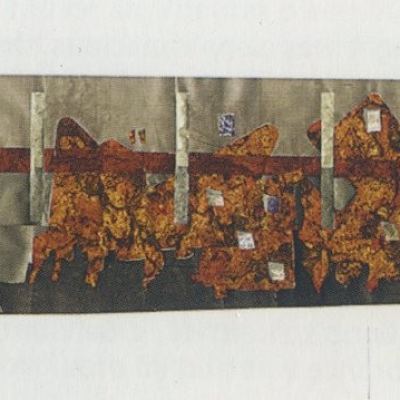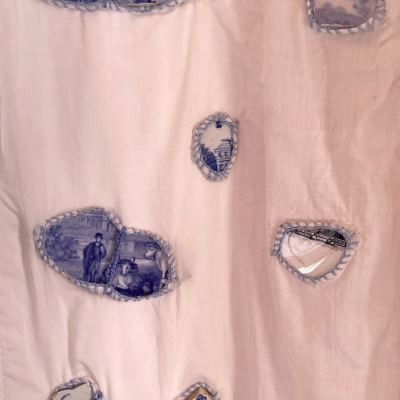Canongate Wall, Edinburgh
Thu 19th Jun 2025
On June 11th 2025, to mark 25 years of devolution and the completion of the Scottish Parliament building, three new quotes were added to the Canongate Wall.
I came to design the Canongate Wall through my friendship with the parliament building’s architects Enric Miralles and Benedetta Tagliabue of EMBT. I became friends with Enric through my architect parents, Alison and Peter Smithson. When Enric died in 2000 Benedetta asked me to suggest a resolution for the Canongate Wall, a 30-metre by 5-metre double curved wall that skirts the Scottish Parliament on Canongate Road from the Queensbury House leading to the parliamentarians’ entrance under the façade of the Canongate building. The shape and length of the wall had been fixed by Enric, as had the need to include 24 quotes selected by an Arts Steering Group.
The selected quotations and text were of relevance to Scotland and the Parliament. They ranged from well-loved pieces of poetry to proverbs and psalms and are in a mix English, Gaelic and Scots language. Many of Scotland's leading writers and thinkers are represented. The original 24 quotes were carved in stone and embedded into the wall. To allow the wall to evolve and reflect the voice of the people a number of recessed spaces were left blank so that further quotes and text could be added.
I intuitively felt my way into the wall’s design using Enric’s sketches, doodles and notes, as well as his reference books on Scotland. I wanted to pay tribute to Enric Miralles as a friend and honour his creative imagination that has made the Scottish Parliament building what it is today, an astonishing testament to what architecture can and should be.
Two quotations, one by Norman MacCaig and one by Mary Brooksbank (the first woman to be represented on the Wall), were added to mark the tenth anniversary of the Scottish Parliament and devolution. Now, to mark 25 years, Liz Lochhead, Jackie Kay and Kathleen Jamie’s words have been added bring the number of quotes to 29. https://www.parliament.scot/visit/events-and-exhibitions/canongate-wall
The sourcing of the stones for the wall from around Scotland and selecting those suitable for letter carving, was done by Gillian Forbes, Martin Reilly and the late Duncan Mills. Each quote is carved into a different type of stone. The Scottish Parliament website has a list of all the quotes and types of stone used. Gillian Forbes, one of the original stone carvers, carried out the letter-cutting for the three new quotes. She was assisted by Cameron Wallace.
I always find it a joy, and also a bit of a surprise, to stand in front of the Canongate Wall and to comprehend that I designed it. I am proud of the wall and I hope that its various elements encapsulate the nation of Scotland; from the undulating strata to the dramatic landscape, in the stones gathered from every shire; Siorrachdan na h-Alba, burgh and isle. Those that I have met who work in the building have told me that they read a quote as they arrive for work, fortifying, uplifting or reflecting on their role, duty and responsibility to the people who they represent. I also feel an affinity to the city of Edinburgh which was strengthened by working on the wall design. My maternal grandmother was Scottish and my mother lived in Edinburgh with her grandmother during the war. Edinburgh’s architecture and town planning were formative for my mother’s architectural career and always held a strong resonance for her, and now me.
Standing anonymously, watching the wall, I have been overwhelmed and delighted by reaction and interaction of those that pass the wall, either regularly as citizens, or irregularly as tourists. I hope the wall acts now and into the future as a representation of the power of people to dream and do remarkable things.
Three new Quotes:
Liz Lochhead
this
our one small country…
our one, wondrous, spinning, dear green place.
What shall we build of it, together
in this our one small time and space?
- from Grace, A Handsel, New & Collected Poems, 2012
Jackie Kay
Where do you come from?
'Here,' I said, 'Here. These parts.'
- from in my country, Darling: New & Selected Poems, 2007
Kathleen Jamie
Be brave:
by the weird-song in the dark you’ll find your way.
- from The Storm, The Bonniest Companie, 2015
The position of Scot Makar, Poet Laureate of Scotland, was created in 2004 by the Scottish Government with support from Creative Scotland. Makar is the Scots word for the author of a literary work, particularly a poet or bard. The role of the Makar is to advance the use of poetry in the lives of the people of Scotland, from all ages and walks of life. Liz Lochhead was the first woman to be Scot Makar, between 2011 to 2016, Jackie Kay the second, 2016 to 2021, with Kathleen Jamie holding the post 2021 to 2024.
Working with memory Fragments. Lecture, Mackintosh Lecture Theatre, Glasgow 2004
My name is Soraya Smithson and I’m an Artist. My parents were Alison and Peter Smithson, architects and architecture teachers. My father taught Enric and he became a family friend. He is the only person I canclaim as a collector of my artwork.
My collaboration with EMBT on the Canongate Wall came about as I was in the right place at the right time.
I was working in Barcelona on a commission from the Col-legi d’Arquitecte de Catalunya (Spanish equivalent to the RIBA- Royal Institute of British Architects) to make what is best described as a mini - memorial sculpture to commemorate Enric’s life and architectural achievement. (The mini refers to the scale of the work, not Enric... he was a big man.) (third from last image)
I was staying with Benedetta and over breakfast we talked. The Canongate Wall had been the only piece of the Scottish Parliament not finalised by Enric before he died.
It’s position and structure was fixed but little else. The Scottish Parliament construction was well under way and it was time for the wall design to be set. The wall is part of the Parliament as a whole, not just a perimeter marker. I think this is an important point. It is an integral piece in Enric’s jigsaw, each part slotting together to make the Whole.
Benedetta thought that fresh eyes looking at the drawings, sketches and notes on the wall would be helpful. I had been working on the design for the memorial piece and so was already fully imbibed with Enricism.
On the morning of my last day in Barcelona I went into the EMBT office and was given access to the books on Scotland and Scottish architecture and to his note books. I photocopied a mass of material then went off to do the other job so it was late that evening before I sat down and collate these gathered images and spliced them together to make a simple black and white college.
At the final breakfast I presented Benedetta with this two-meter-long collage. I thought I was only providing a visual springboard of ideas to regenerate thought within the office.
Benedetta was enthusiastic – she is an enthusiastic woman – but looking back I can see that for Benedetta what I presented to her then was a foregone conclusion. That was it. She imagined the finished article in situ with all issues negotiated and resolved.
I returned to England and hoped I had been helpful. A week later Benedetta rang to say they were sending drawings of the wall for me to look at and make comments on. Joan Callis had set to work on my departure to translate my college into the three-dimensional form that is now seen in Edinburgh.
All along I was very conscious that what I was doing was for two clients, Enric and Scotland. Working to meld surface and structure. The wall is a composite of textures, text, line and Stone. Derived from Scottish nature, Scottish vernacular, painted ceilings, cigar boxes, Enric’s Sketches, a Balkan children's remembrance wall and so on....
I think the wall is beautiful but it is a structure not a sculpture and its beauty the product of the collaborative work; architects, engineers, stone carvers, concrete casters and the construction team. Their skill and dedication to the job makes the piece seem effortless, simple, correct and that's what makes a good piece of work.
There is an art work of the wall, a four meter fully worked coloured college that I made in the summer of 2002 and now hangs in the office of EMBT. (penultimate image)
What I hope for the wall is that my contribution and that of all those involved has imbued it with sensitivity to satisfy the people of Scotland.
The image below is of a section of a cloth hanging made by my mother using broken shards of china shards found at the Robin Hood Lane building site in London's East End. It is one of a pair that used to hang in my parent’s office and which now hang in my sitting room. Something new from something found. Another curved concrete wall that is more than a perimeter. (last image)
